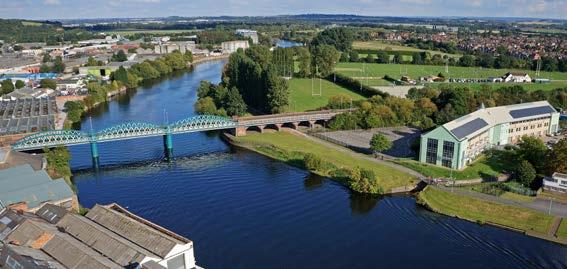
3 minute read
Pete Harrison (Marine Biology, 1994)
Pete joined the EDF in April as Executive Vice President for Regions, a new role in which he will support the US-based organisation’s global expansion, overseeing teams in China, Europe, India and the United States.
Based in Brussels, Pete has spent the last decade at the European Climate Foundation (ECF), which is Europe’s largest philanthropic funder of initiatives to tackle climate change. Since 2018, he has been the ECF’s executive director for EU policy during a period that included preparations for the EU Green Deal, with the goal of making Europe the world’s first climate neutral continent. Prior to that, he spent four years as director of the ECF’s Transport Program, where he deployed strategies that have contributed to Europe’s rapid advances toward phasing out combustion engines and bringing in an era of e-mobility.
Elliott Corke
I can honestly say I’ve never felt so scared in my life, but I quickly made friends at Reichel and got settled into what was to become five years amongst what I consider some of the most stunning scenery in the world. Alongside my marine biology studies, I joined the fencing and mountain walking clubs as well as the Christian union where I made lifelong friends and also met Lucy who studied German and has now put up with me for 27 years!
Although I really enjoyed my degree work, carrying out my dissertation under the supervision of Dr John Latchford, I wasn’t sure what to do after graduating, so I spent a year working at an outdoor centre near Bala and then, having discovered a love for education, came back to Bangor to complete a PGCE specialising in biology. When we left Bangor, I applied for various teaching posts and got a job teaching biology in Norwich, moving from one of the most mountainous areas of the UK to one of the flattest. I taught biology and environmental science in several secondary schools in Norfolk for 10 years before leaving teaching and it was in 2011 that a friend introduced me to drones. I did a bit of research which resulted in me starting my drone company HexCam, using the new technology to obtain quite basic aerial photography and video at that point. Due to my background, I quickly gained clients such as the Broads Authority and the Norfolk Wildlife Trust, who were beginning to use drones to monitor their environmental sites across Norfolk. I also carried out filming work for various documentaries and corporate films.
However, as I was early in the industry, people started asking me to train them; so I used my teaching background to set up another business that eventually became Global Drone Training whilst passing the reins of HexCam on to two other drone pilots. Global Drone Training has allowed me to pass my love of the many uses of drone technology on to hundreds of people and given me the opportunity to travel widely in the UK, Europe and Africa. We have training bases in Senegal and Tanzania, collaborating with WeRobotics to develop local expertise. One of my highlights so far was to visit The Gambia to train the National Disaster Management Agency (NDMA) in the use of drones for mapping to assess flood risk and increase flood resilience. HexCam has developed a specialism in 2D and 3D mapping and modelling, and most of our operational work is on large infrastructure projects such as monitoring the onshore and nearshore elements of the growing East Anglian offshore renewables sector. In Global Drone Training we have environmentally-focused clients such as CEFAS, Norfolk Rivers Trust, NIAB and various universities and I am always happy to talk about the application of drones in different sectors and how to get the best out of them.


Lucy and I visited North Wales and Bangor last year with our sons and it was great to take a walk to the end of the pier and up to Roman Camp and reminisce about the amount of time I spent on and in the Menai Strait. It was such a formative and wonderful time for me, and I am glad that I can now put my degree knowledge to good use in my chosen career. I’ll leave you with two bridges. The first is the Lady Bay Bridge in Nottingham, with the Environment Agency offices on the right, which is one of the first I photographed using a drone. The second is the politically important Senegambia Bridge in The Gambia, photographed during our NDMA training project.











